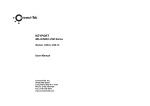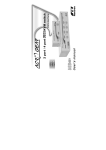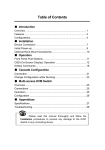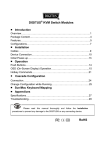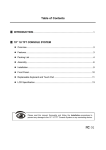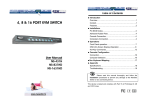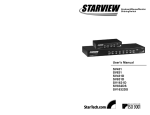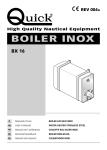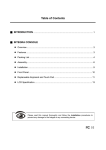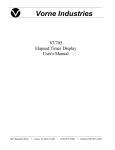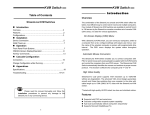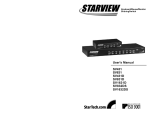Download Manual - Rextron
Transcript
AcroGear User Guide Table of Content < Introduction Overview… … … ...… … … … … … … … … … … … … … … … ..… .1 Package Content… … … … … … … … … … … … … … … … ..… ..1 Features… … … … … … .… … … … … … … … … … … … … … … ..4 < Installations PC BIOS Notice.… … … … … … … … … … … … … … … … … … .5 Adhesive Rubber Feet.… … … … … … … … … … … … … … .… .6 Console Connection… … … … … … .… … … … … … … … ..… ...6 Computers Connection… … … … … … … … … … … … … .… … .6 < Operations Front Panel operation… … … … … … … … … … … … … … ...… .9 OSD (On-Screen Display) Operation… … … … … … … … ....10 Hot-Key Commands… … … … … … … … … … … … … … … .… 15 < Cascade Configuration Connection… … … … … … … … … … … … … … … … ...… ..… ...17 Computer Selection… ..… … … … … … … … … … … ..… ..… ...17 <Sun Keyboard Mapping… … … … … … … … ...… … … .… … .18 < Appendix Specifications… … … … … … … … … … … … … .… … … … … … 19 Troubleshooting… … … … … … … … … ..… … ...… .… … … … ..20 Please read this manual thoroughly and follow the Installation procedures to prevent any damage to the AcroGear or any connecting device. ----------------- Introduction Overview The hybrid USB and PS/2 KVM switches – KAG104, KAG104D, KAG108D, and KAG116D extend your computer management to either PS/2 and/or USB models, or both from a single PS/2 console. With the Sync-EmuTM Technology, the advanced KAG104D, KAG108D, and KAG116D are designed to meet the special requirements from USB-ready HP Unit systems and Sun servers. Engineered for servers of the highest level, the KAG104D, KAG108D, and KAG116D guarantee flawless switching with zero tolerance. Installation is as easy as connecting USB A -B cables or PS/2 cables in between computers and the KAG switch. Selecting a computer is as easy as front panel button pressing or by entering hotkey commands. The innovated KVM technology ensures smooth switching from one computer to the other and signal conversion from PS/2 to USB. No more tangled cables and messy working environment; let the KAG switches do the computer switching for you. Package Content KVM switch x 1 Power Adapter x 1 Foot Pad x 1 set This device is tested and complies with Part 15 of FCC/class B, CE and VCCI rules. Bracket x 2 (optional) User’s Manual x 1 PS/2 Y-Adapter x 4/6/12 for 4/8/16-port model 1 AcroGear User Guide AcroGear User Guide 4-port KVM Switch configuration 16-port KVM Switch configuration 8-port KVM Switch configuration 2 3 AcroGear User Guide AcroGear User Guide ----------------- Installation Features PC BIOS Notice l Manage from 4 to 16 USB-enabled PCs, iMacs from one PS/2 keyboard, one mouse, and one monitor. l For computer with USB or PS/2 interface. l Front panel push-buttons for easy computer selection. l Support keyboard and mouse Plug-and-Play. l Buzzer sound for computer switching confirmation. l High VGA resolution up to 1920*1440. l Activate Auto Scan by front buttons pressing. l USB specification compliant. l Support the latest DDC2B VGA monitor. l OSD menu for server naming and selection. (OSD Models only) l Support USB-ready HP Unix and Sun servers. (OSD Models only) The following BIOS setup changes are necessary for PC users using USB and not necessary for Mac users: 1. In STANDARD CMOS, set HALT ON ERROR to ALL BUT KEYBOARD. 2. In PNP AND PCI SETUP, set PNP OS INSTALLED to YES and set USB IRQ to ENABLED. 3. For newer computers: in INTEGRATED PERIPHERALS, set USB CONTROLLER and KEYBOARD SUPPORT to ENABLED. Also, make sure USB is properly selected in Device Manager under Control Panel, as shown in Figure 1. Figure 1: PC BIOS Notice Note: For KAG104, switching from one computer to the other is equivalent to unplugging the USB device from one computer and plugging it to another. For certain computers neither accept plug-and-play nor USB hub, the OSD models deal with it by the advanced Sync-EmuTM Technology emulating USB devices at all ports individually. 4 5 AcroGear User Guide Adhesive Rubber Feet For the desktop operation, you may stick the four round rubber feet (supplied with the unit) to the bottom of the AcroGear. NOTE: Give the rubber feet a firm press to the enclosure when applying them. Do not use the rubber feet for rack mount operation. AcroGear User Guide = For USB computer: Use a USB A-B cable to connect from one of the PC ports to the USB port on the corresponding computer (A connector, flat connector), as shown in Figure 3. Console Connection Before installation, make sure all devices and computers to be connected to the KVM switch have been turned off. Plug a monitor to the Console's VGA port; connect a PS/2 mouse and a keyboard to the CONSOLE port marked with a mouse and a keyboard as shown in Figure 2. Figure 3: Computer USB Port Connection = For PS/2 computer: Connect a "PS/2 Y-adapter", come with the unit, to the PS/2 port at PC side, then use two mini-DIN6 male-to-male cables for keyboard and mouse, see Figure 4. There are two mini-DIN6 female connectors on the "PS/2 Y-adapter" marked with keyboard and mouse, be sure not to swap the connections. Figure 2: Console Connection Computers Connection Use a HDB15 male-to-female cable to connect from a computer's VGA output to VGA port of PC side, as shown in Figure 3, Figure 4, and Figure 5. 6 Figure 4: Computer PS/2 Port Connection 7 AcroGear User Guide = For Laptop computer: In most cases, all you need is one PS/2 male-to-male cable connected between the KVM switch and your Notebook; the Y-adapter is not necessary. However, some Laptop computers do not follow industry standard, please check your Laptop user's manual for details. AcroGear User Guide ----------------- Operations Front Panel < On-line LED & Selected LED When the LED turns green, the connected computer is powered-on. When a computer is selected, its corresponding red LED illuminates. < Push-buttons Each computer has a button associated with it on the front panel for selection. < K/M RESET K/M RESET solves most problems developed by keyboard, mouse, device replacement or change of configuration. Press down both the front-panel number 1 and 2 push buttons for 2 seconds to re-configure the whole system without turning either the USB KVM switch or any computer off. Figure 5: Laptop PS/2 Port Connection Now, you can turn on all devices and computers. Note: Do not connect both PS/2 and USB ports of one PC port on the KAG104 to a computer; otherwise, only the USB port is effective at a time. < AUTO SCAN Auto Scan automatically scans through computers one by one in a fixed interval (see Scan Time below). To initiate Auto Scanning, for KAG104 and KAG104D, you can press down both the front-panel number 3 and 4 buttons for 2 seconds. For KAG108D and KAG116D, press 7 and 8 instead. Note: For KAG104 model only: computers using USB keyboard and mouse are not immediately operable when selected during Auto Scan. Wait for about three seconds after switching to a USB computer, and then use the keyboard and mouse. 8 9 AcroGear User Guide OSD (On-Screen-Display) Operation KAG OSD models only AcroGear User Guide The color of a device name is green if it has power and is ready for operation, or the color is white, as it has no power. OSD menu updates the color when it is activated. The PageUp and PageDown keys can be used to view 8 other computers at a time, KAG108D, for example. For example, KAG116D, using the “ é “, “ ê “, “ 1 “ ~ “ 8 “, or “ A “ ~ “ H “ to highlight a computer and then press the Enter key to select it. Or, you may press the Esc key to exit OSD and remove the OSD menu from the display; the status window returns to the display and indicates the currently selected computer or operating status. A triangle mark (4) to the right of a name indicates the port is cascaded to a Slave; the number at the left of the triangle mark shows the number of ports the Slave has, i.e. 84for an 8-port switch. The Enter key brings you one level down and another screen pops up listing the names of the computers on that Slave. The name of the Slave will be shown at the upper right corner of the OSD menu. It is useful to group computers and still be able to see the group name. An eye mark (N) to the right of a name indicating the computer is selected to be monitored in Scan mode. In OSD, this mark can be switched on or off by the function key F2 . Press the Esc key to exit OSD and to return to the selected computer; the computer name is also shown on the screen. Figure 6: OSD screen illustration By hitting the left Ctrl key twice within two seconds, you may see the 'Hotkey Menu' if it is enabled (an OSD option). Or, by hitting the left Ctrl key three times within two seconds, you will see a 'KVM MENU' screen showing a list of the computers with corresponding port numbers, names and status, see Figure 6. =Function key F1 : To edit name entry of a computer or a Slave with up to 14 characters. First, highlight a port then press F1 followed by name entry. Valid characters are ‘A’~’Z’, ‘0’~’9’ and the dash character. Lowercase letters are converted to uppercase ones. Press Backspace to delete a letter one at a time. Non-volatile memory stores all name entries until you change, even if the unit is powered down. The port number of the currently selected computer is displayed in red, same as the front indicator, at the right corner of the OSD menu. 10 11 AcroGear User Guide AcroGear User Guide =Function key F2 : To switch the eye mark (N) of a computer on or off. First, use the UP and DOWN arrow keys to highlight it, then press F2 to switch its eye mark on or off. If Scan Type is 'Ready PC +N', only the power-on and eye mark selected computers will be displayed sequentially in Scan mode. In this mode, the KAG automatically switches from one power-on computer to the next sequentially in a fixed interval. During Auto Scan mode, the OSD displays the name of the selected computer. When Auto Scan detects any keyboard or mouse activity, it suspends the scanning till activity stops; it then resumes with the next computer in sequence. To abort the Auto Scan mode, press the left Ctrl twice, or, press any front button. Scan Type and Scan Rate set the scan pattern. Scan Type ( F4 : More\Scan Type) determines if scanned computers must also be eye mark selected. Scan Rate ( F4 : More\Scan Rate) sets the display interval when a computer is selected before selecting the next one. =Function key F3 : To lock a computer from unauthorized access. To lock a device, highlight it then press F3 . Now, enter up to 4 characters (‘A’~’Z’, ‘0’~’9, ‘-‘) followed by Enter as new password. A Security-enabled device is marked with a lock (Ï) following its port number. To permanently disable the security function from a locked device, highlight it, press F3 then enter the password. n If you want to access the locked device temporarily, simply highlight it and press Enter , the OSD will ask you for the password. After entering the correct password, you are allowed to use the device. This device is automatically re-locked once you switch to another port. During Scan mode, OSD skips the password-protected ports. If you forget the password, the only way to permanently erase all the passwords is to: For 108D and 116D, press and hold the front panel buttons “1” and “2”, then hold “7” and “8”. Release “7” and “8”, then release “1” and “2”. For 104 and 104D, press “3” and “4” instead of “7” and “8”. =Function key F4 : More functions are available by hitting F4 . A new screen pops up displaying more functions as described below. Most of them are marked with a triangle (4) indicating there are options to choose from. Using the UP and DOWN arrow keys, select the functions and press Enter . Available options will be shown in the middle of the screen. Again, using the UP and DOWN arrow keys to view options then press Enter to select it. You can press Esc to exit at any time. n Auto Scan 12 n Manual Scan Scan through power-on computers one by one by keyboard control. Type ( F4 : More\Scan Type) determines if scanned computers must also be eye mark selected. Press the up arrow key é to select the previous computer and the down arrow key ê to select the next computer. Press any other key to abort the Manual Scan mode. Scan Type Ready PC +N : In Scan mode, scan through power-on and eye mark selected computers. Ready PC: In Scan mode, scan through power-on computers. N Only: In Scan mode, scan through any N selected computer regardless of computer power status. The non-volatile memory stores the Scan Type setting. n Scan Rate Sets the duration of a computer displayed in Auto Scan mode. The options are 3 seconds, 8 seconds, 15 seconds and 30 seconds. The non-volatile memory stores the Scan Rate setting. 13 AcroGear User Guide AcroGear User Guide n Keyboard Speed KAG offers keyboard typematic setting that overrides the similar settings in BIOS and in Windows. Available speed options are Low, Middle, Fast and Faster as 10, 15, 20 and 30 characters/sec respectively. The non-volatile memory stores the Keyboard Speed Setting. n n n n higher the resolution the higher the display position. The non-volatile memory stores the Position setting. Audio Stick An optional multimedia module can be linked to the back of each Integra KVM switch for selecting microphone and stereo speaker signals. There are two options for Audio Stick: ON and Off. When set to 'On', audio selection follows computer selection. When set to 'Off', audio selection stops following computer selection. It is useful if you want to listen to a particular computer's audio signal while operating other computers. The non-volatile memory stores the Audio Stick setting. Hotkey Menu When you hit the left Ctrl key twice within two seconds, the "Hotkey Menu" appears displaying a list of hot-key commands if the option is On. The 'Hotkey Menu' can be turned Off if you prefer not to see it when the left Ctrl key is hit twice. The non-volatile memory stores the Hotkey Menu setting. CH Display Auto Off: After you select a computer, the port number and name of the computer will appear on the screen for 3 seconds then disappear automatically. Always On: The port number and name of a selected computer and/or OSD status displayed on the screen all the time. The non-volatile memory stores the CH Display setting. Position The position of the selected computer name and/or OSD status displayed on screen during operation. The actual display position shifts due to different VGA resolution, the 14 Upper Left, Upper Right, Middle. Lower Left, Lower Right. n Country Code for Sun Sun keyboards of different languages have different layouts. The KVM switch is able to emulate a Sun keyboard for a specific language type or country such as Arabic, Belgian, US, Yugoslavia, and so forth. Select the proper country code that matches ALL of your Sun computers. =Function key F5 : To switch the Sun mark of a port on or off indicating the computer is a Sun server. Sun servers have more keys on the keyboard than a PC. When a Sun-marked port is selected, the KVM switch starts to translate the keys from a PS/2 keyboard to a Sun keyboard. See Sun Keyboard Mapping for detail. = Esc : To exit the OSD, press the Esc key. Hot-key commands Hot-key command is a short keyboard sequence to select a computer, to activate computer scan, and so forth. The USB KVM switch interprets keystrokes for hot-keys all the time. A hot-key sequence starts with two left Ctrl keystrokes followed by one or two more keystrokes. A built-in buzzer generates a high-pitched beep for correct hot-key command; otherwise, one low-pitched beep for error and the bad key sequence will not be forwarded to the selected computer. L-CTRL: is the Ctrl key located at the left side of the keyboard. 1~8: are the number keys '1' ~ '8' at the upper row of the keyboard. Do not use the keypad at the right of the keyboard. 15 AcroGear User Guide A~H: represents from Port 9 to Port 16 g To select a computer by hot-key command, you must know its port address, which is determined by the AcroGear connection at the back. For example: left Ctrl + left Ctrl + 4 Selects a computer connected to the PC port 4. AcroGear User Guide ----------------- Cascade Configuration Connection Before connecting a device (a computer or another KAG product) to the master under power, you must turn off the device. Only PS/2 port is operable for cascade operation, see Figure 7 for details. g To start Auto Scan, automatically scan power-on computers one by one at a fixed interval: left Ctrl + left Ctrl + F1 When Auto Scan detects any keyboard or mouse activity, it suspends the scanning till activity stops; it then resumes with the next computer in sequence. The length of the Auto Scan interval (Scan Rate) is adjustable, please see below. To abort the Auto Scan mode, press the left Ctrl key twice. g Manual Scan enables you to manually switch back and forth between power-on computers. left Ctrl + left Ctrl + F2 Figure 7: Cascade Connection Press é or ê to select the previous or the next computer in sequence. And, press any other key to abort the Manual Scan. g To adjust Scan Rate which sets the duration before switching to the next computer in Auto Scan: left Ctrl + left Ctrl + F3 The AcroGear sends one to four beeps indicating scan interval of 3, 8, 15 and 30 seconds respectively. g To adjust keyboard typematic rate (characters/sec), this setting over-rides that of BIOS and any operating system: left Ctrl + left Ctrl + F4 The AcroGear generates 1 to 4 beeps corresponding to 10, 15, 20 and 30 characters/sec respectively. 16 Note: The Master must have equal or more ‘PC x’ports than that of the slave, i.e., if an 8-port switch is the Master, an 8-port or 4-port switch can be a Slave, but not a 16-port one. PS/2-only models can be cascaded with USB-PS/2 universal models. Computer Selection by Hot-Key Command The first digit is the port address of the Master unit (1~8) and the second digit is the port address of the Slave (1~8,A~H). Please note that only Master's PS/2 ports can be connected to a Slave's CONSOLE port. left Ctrl + left Ctrl + 1 + 3 Selects a computer connected to PS/2 or USB port 3 of a Slave connected to PS/2 port 1 of the Master. 17 AcroGear User Guide ----------------- Sun Keyboard Mapping (OSD models only) The OSD models emulate a Sun’s keyboard and mouse when a computer is marked with a Sun in OSD menu by Function key F5 A Sun keyboard has more keys than a standard PS/2 one. These extra keys are simulated by tapping the lower-right Ctrl followed by one of the function keys on a PS/2 keyboard (i.e. combo key) For instance, tap the lower-right Ctrl key, then tap the function key F7 to activate Open for a Sun computer. PS/2 keyboard right - Ctrl 1 right - Ctrl 2 right - Ctrl 3 Sun keyboard AcroGear User Guide ----------------- Appendix Specifications Specification KAG104 KAG104D No. of computers supported 4 Front panel push button 4 Hot plug-and-play Ctrl 4 right - Ctrl F1 Stop right - Ctrl F2 Again right - Ctrl F3 Props right - Ctrl F4 Undo right - Ctrl F5 Front right - Ctrl F6 Copy right - Ctrl F7 Open right - Ctrl F8 Paste right - Ctrl F9 Find right - Ctrl F10 Cut right - Ctrl H Help right - right - ♦ left - left - ♦ Compose right - Alt Alt Graph left - Alt Alt 18 KAG116D 8 16 8 16 Yes Hot-key Control Yes On-screen display (OSD) No Sync-Emu Technology No Yes Yes Automatic scan interval 3, 8, 15, 30 seconds Cable Length (Max) 30M(100ft) for VGA 5M(15ft) for USB 30M(90ft) for PS/2 note right - KAG108D Computer ON-LINE LED 4 8 16 Computer selected LED VGA 4 8 16 Computer peripheral connector monitor 1920 X 1440, DDC2B USB Type B x 4, PS/2 x 3 HDB15 male x 4 USB Type B x8, USB Type Bx16, PS/2 x 8 PS/2 x 16 HDB15 male x 8 HDB15 male x 16 PS/2 x 2 HDB-15 female x 1 Console peripheral connector monitor Weight (g) (oz) 900 31.74 H x W x D (mm) (in) 44 x 220 x 130 1.75 x 8 .75 x 5.125 Size Compact 2400 84.66 44 x 436 x 180 88 x 436 x 220 1.75 x 17.25 x 7.0 3.5 x 17.25 x 8.7 1U 19 3700 130.5 2U AcroGear User Guide AcroGear User Guide ----------------- Troubleshooting Ensure that all cables are well seated. Label the cable for each computer to avoid confusion when connected to the KAG104, KAG104D, KAG108D, and KAG116D. Symptom Causes Solutions l Keyboard or l In Auto Scan, mouse does not computers using USB work. keyboard and mouse are not operable. l Too many keyboard or mouse drivers installed in one computer. l Keyboard or l The USB computer mouse does not does not support work after plug-and-play as switching to a specified by USB different USB standard. computer. l Computer hangs up while switching computer. l USB computer initialization takes too much time. l Auto Scan does l All PCs are off or only not switch PC one PC is turned on. automatically Scan mode works for and the switch power-on computers beeps. only. l Unable to l The server does not control a Sun support USB server or a HP plug-and-play or USB Unix system. hub. l Unable to control a Sun server while using OSD models. l Sun mark is not tagged in OSD menu. 20 l Press any front button to select a computer, then use the keyboard and mouse. l Remove ALL unnecessary keyboard and mouse drivers. l Update that computer's USB driver. Device hot plug-and-play is one of the basic USB specifications. OSD models is better suited for this environment l Wait at least 5 seconds before switching from one USB computer to another to ensure proper USB communication. l Turn computers on. l The Sync-Emu™ technology of OSD models solves this problem. PS/2 keyboard Sun keyboard right - Ctrl 1 right - Ctrl 2 right - Ctrl 3 right - Ctrl 4 right - Ctrl F1 Stop right - Ctrl F2 Again right - Ctrl F3 Props right - Ctrl F4 Undo right - Ctrl F5 Front right - Ctrl F6 Copy right - Ctrl F7 Open right - Ctrl F8 Paste right - Ctrl F9 Find right - Ctrl F10 Cut right - Ctrl H Help note right - right - ♦ left - left - ♦ Compose right - Alt Alt Graph left - Alt Alt " l Make sure each Sun server is tagged with a Sun mark in the OSD menu by Function key F5 . 21 Limited Warranty IN NO EVENT SHALL THE DIRECT VENDOR'S LIABILITY FOR DIRECT OR INDIRECT, SPECIAL, INCIDENTIAL OR CONSEQUENTIAL DAMAGES, LOSS OF PROFIT, LOSS OF BUSINESS, OR FINANCIAL LOSS WHICH MAY BE CAUSED BY THE USE OF THE PRODUCT EXCEEDS THE PRICE PAID FOR THE PDOCUDT. The direct vendor makes no warranty or representation, expressed or implied with respect to the contents or use of this documentation, and especially disclaims its quality, performance, merchantability, or fitness for any particular purpose. The direct vendor also reserves the right to revise or update the product or documentation without obligation to notify any user or organization of such revisions or updates. For further information, please contact your direct vendor. All the brand names and registered trademarks are the property of their respective owners. * HP is a registered trademark of Hewlett-Packard Company. * Sun is a registered trademark of Sun Microsystems. PP5-G0400-000












